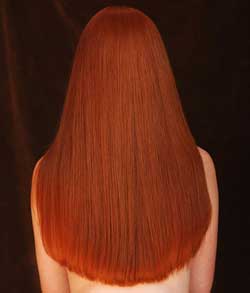Mesotherapie therapy for hair loss
Hair loss is a difficult to treat disease, the treatment effect is often low. However, a new method can improve this: it is Mésothérapie - injections into the scalp. Drugs increase blood circulation in place and nourish hair roots.
There are many types of hair loss:
'Fake' hair loss : T

(Photo: rosannas)
The mind often sheds a lot in spring and autumn. After puberty and around 40 years of age there is also hair loss because of changes in hormones that reduce physiological hair.
Hair loss scattered without inflammation : Acute hair loss when suffering from mental shock due to childbirth, miscarriage, severe fever, surgery, strong emotion. Or chronic hair loss due to Biotine deficiency, iron and zinc; by taking some drugs (anti-cancer, anti-clotting, epilepsy treatment .). Hair loss can also be caused by endocrine because of increased or decreased thyroid function, parathyroid disease, diabetes, red lupus, lack of calcium in the blood, anemia.
Hair loss due to many male hormones or oily skin : This is the most common cause. Hairline is influenced by genetic factors and sensitivity to male hormonal changes makes hair growth time shorter. The disease usually occurs in puberty in men and about 30 years in women.
In men, hair falls off in waves of about 3-4 months and is replaced by smooth hair like hair. First, the small concave hair falls between the forehead and temples; and then spread out in a spiral, to the top of the head. After that, the hair is only in the temporal and occipital areas. In the last stage, the hair is very little, only a narrow, thin band, around the bottom, back and sides of the head.
In women, hair falls in waves, about two episodes each year, often seasonally and possibly due to genetic effects. In the early stages, hair falls on the top of the head and there is an image that looks like the hairline turns wide. The disease then spreads forward to about 1 cm from the frontal hairline, eventually losing hair to the top of the head. It may be accompanied by signs of increasing the amount of male hormones such as acne, excessive hair growth, menstrual disorders, maleization .
Limited hair loss is not marked by scalp scars:
Alopecia (also known as pelade): Appears one or more places completely without hair, the rest is normal. This form can spread from several points towards complete hair loss. This progress is unpredictable. The cause may be due to plant neurological disorders, endocrine (abnormal thyroid function), emotional shock, the cause of autoimmune disease (most likely, but not currently proven ).
Traumatic hair loss: Hair falls off each sequence, the limit is unclear, the hair has different lengths. Common after trauma causes scalp hematoma, after surgery . Hair loss due to bacterial or fungal infections is characterized by hair loss of each point with broken, short hair.
Hair loss due to scalp scar : A large scar that causes the hair follicles to be destroyed and cannot be recovered.
If hair loss is caused by an infection or fungal infection, special treatment with appropriate antibiotics and antifungals is necessary. Drugs that limit hair loss include: vitamins B5, B6, amino acids such as cystine, cystéine, méthionine. In addition, the doctor can administer topical cortisone, anti-allergy treatment in the scalp (to reduce hair loss caused by autoimmune disease), stimulate the scalp with cold temperatures.
The relatively effective hair loss medication is Minoxidil , used topically, which increases hair volume by about 30%. However, the drug also has side effects such as affecting blood pressure, causing heart palpitations, water retention. Results from 4 to 6 months have results. In addition, there are male hormones (only for women), topical immunostimulants (isoprinosine), used in cases of high hair loss.
A new method has appeared, which is to inject medicine to the scalp (Mésothérapie) . This method is used to treat hair loss very effectively, increasing local blood circulation and nourishing hair roots. The principle of treatment is microcirculation and topical nourishment with important vitamins; Slow down the degeneration of hair roots.
Treatment: Spot the scalp hair once a week for 4 weeks in a row; then every 2 weeks, 4 times. Next, every month or 2 months. Avoid shampooing or dyeing your hair 24 hours later.
Statistics show that after 4 treatments, hair loss is about 90%; Scalp mucus decreases after 3 weeks. Hair begins to grow after 3 months; The younger the child, the faster the hair grows.
- Prevent early causes of hair loss
- Helmets help grow hair
- Air pollution can cause hair loss, baldness
- Artificial hair follicles help treat hair loss
- The cure for silver hair does not require dyeing
- The hat is anti-hair loss when chemotherapy
- Using ginger to treat dandruff, hair loss is more effective than medicine
- Side effects of radiation therapy and limited ways
- Unexpected method to help treat hearing loss
- The doctor was surprised because the cancer patient did not suffer from hair loss during chemotherapy
- Breakthrough in the treatment of hearing loss by gene therapy
- The virus helps deaf mice hear sounds
 Green tea cleans teeth better than mouthwash?
Green tea cleans teeth better than mouthwash? Death kiss: This is why you should not let anyone kiss your baby's lips
Death kiss: This is why you should not let anyone kiss your baby's lips What is salmonellosis?
What is salmonellosis? Caution should be exercised when using aloe vera through eating and drinking
Caution should be exercised when using aloe vera through eating and drinking